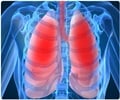PHILADELPHIA – Researchers at the University Of Pennsylvania School Of Medicine are exploring an investigational treatment
PHILADELPHIA – Researchers at the University Of Pennsylvania School Of Medicine are exploring an investigational treatment which promises a novel , minimally-invasive option for those suffering advanced widespread emphysema. The EASE (Exhale Airway Stents for Emphysema) trial targets a procedure called airway bypass that creates pathways in the lung for trapped air to escape; this is capable of alleviating emphysema symptoms like breathlessness.
Emphysema, most often brought on by smoking, affects an estimated 60 million people worldwide with more than 3 million sufferers in the United States. There is no cure. It's a chronic, progressive, and irreversible lung disease characterized by the destruction of lung tissue. The loss of the lungs' natural elasticity and the collapse of airways in the lung combine so that the lungs can no longer deflate to let air in. The patient is in a permanent state of "breathlessness" – sucking in rapid, shallow breaths. Even the most nominal physical activities become difficult for emphysema patients and many become dependent on oxygen therapy.Researchers at the University of Pennsylvania School of Medicine are now studying an investigational treatment for emphysema, an airway bypass procedure. Physicians create new small pathways using a special needle...
"There are limited treatment options right now for these patients who struggle for each breath," comments John Kucharczuk, MD, principal investigator, thoracic surgeon, and Assistant Professor of Surgery at Penn. "This new, cutting-edge, non-surgical procedure actually creates new pathways for airflow and could offer another option for those who would otherwise possibly spend years waiting on a lung transplant list."
During the airway bypass procedure, physicians first use a Doppler probe inserted through a flexible bronchoscope (a commonly used way to go through the mouth and into the lungs to examine the airways) to identify sites away from blood vessels. Then the physician creates new small pathways using a special needle to make small openings. Stents are then put in place to keep the new passageways open.
This image shows the damaged lung tissue of an emphysema patient. Researchers at the University of Pennsylvania School of Medicine are now studying an investigational treatment that may offer.
The procedure involves placing up to six Exhale® Drug-Eluting Stents – manufactured by Broncus Technologies, Inc. - to allow the trapped air in the lung to escape. Again, it is hoped this will deflate the lungs, by essentially creating a few new unobstructed air pathways, so that the patient can breathe more easily. The total time of the procedure is approximately one to two hours.
Advertisement
Sterman adds, "Given that emphysema is such a devastating disease associated with permanent destruction of the small air sacs (alveoli) which allow the lungs to function -- any new potential intervention could offer substantial relief to the millions of sufferers in this country."
Advertisement
SAV/M








